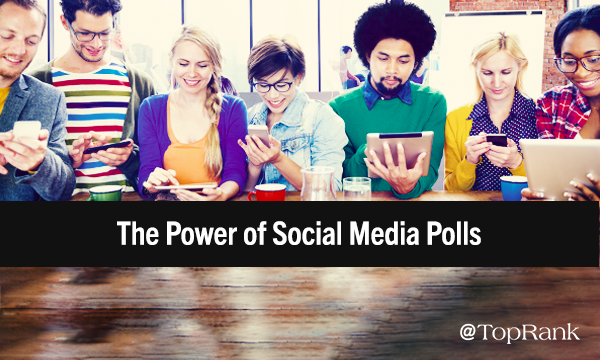Author: Nick Nelson / Source: Online Marketing Blog – TopRank®

Let’s take a trip down memory lane, all the way back to 2007.
The world was a different place. Rihanna’s “Umbrella” (ella, ella) dominated the Billboard Charts. Scorsese’s masterpiece The Departed won Best Picture. Facebook was only a year removed from opening its membership to the general public, and Twitter was a fledgling startup, still looking to gain traction.
But even then, online polls were already emerging as an intriguing tool for digital marketers. On this blog, TopRank Marketing CEO Lee Odden penned a post about the relatively nascent tactic, which could be utilized through a modest WordPress plugin.
“If you want to know what your users are thinking,” Lee wrote. “Just ask them.”
It’s a simple premise, and one that hasn’t changed over the past decade, although the tools at our disposal have evolved considerably. Today, audience polls are integrated features on most major social media networks.
As marketers seek new ways to drive engagement and gather data, the allure of social media polls is obvious.
Let’s take a look at how polls work on each platform, what kind of value they can provide, and how to get the most out of them.
The Polling Details
Users on Twitter could informally run polls in the platform’s early days — by manually tracking responses, hashtags, or retweets — but the official Twitter polls feature was launched in 2015. This made it easy to create sleek, interactive, customized polls with two (and later up to four) options.
Lee frequently runs polls like this one on Twitter to gauge the opinions of his followers on various subjects:
The folks at @workfront have a new post about 4 motivators potentially greater than money that can light a fire amongst your marketing or agency team. Which of these would you rate as the bigger motivator for you?
Read the full post: https://t.co/nmo4GiAOPv
— Lee Odden (@leeodden) June 12, 2018
What Makes Twitter Polls Engaging
Staying in line with the overall appeal of Twitter, polls are extremely easy to participate in — one quick click of the mouse or tap of the mobile screen.
How to Get Twitter Polls Right
Knowing that the platform is built around quick-scrolling and bite-sized content, you’ll want to to ensure these polls are light on text, and eye-catching. Maybe include a couple of emojis, like HootSuite does here:
When do you see the most engagement on your social networks? ? ? #twitterpoll
— Hootsuite (@hootsuite) July 11, 2017
Instagram Polls
In 2017, Instagram rolled out its own polling convention, which became a part of its Stories feature. Instagram polls are added in the form of interactive stickers with two options that you can drag-and-drop on visual content you’ve created.
As is the nature of the platform, polls will usually pertain to the content of the post in question. (“Which color shirt do you like better?” or – in the example below via the company’s official announcement post – “Which donut should I eat?”)

(*Extremely Homer Simpson voice* Mmm, donuts…)
What Makes Instagram Polls Engaging
This is an excellent avenue for quickly gathering feedback around something people can see right in front of them. And you’ll have many options for making them stand out aesthetically.
How to Get Instagram Polls Right
If you have a sizable and engaged Instagram following, you could enlist your audience to help guide a decision (a la M&Ms). Customers might be more attached to what you’re doing if they feel like they played even a small part in directing it.
You may also try using polls for more general topics or market research – Instagram does have…
Peter Bordes Jr
Founder & Managing Partner Trajectory Ventures. Lifetime entrepreneur, CEO, Board Member, mentor, advisor and investor.
Obsessed with the infinite realm of possibility in disruptive innovation driving global digital transformation in technology, cloud-based infrastructure, artificial intelligence, data, DevOps, fintech, robotics, aerospace, blockchain and digital media and advertising.

